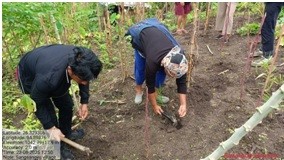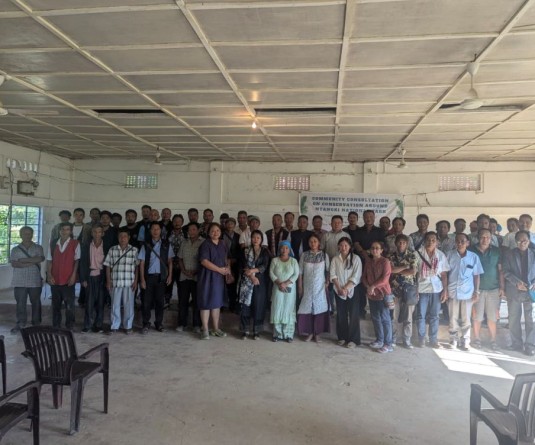
Tuensang, August 24 (MExN): In an effort to promote indigenous knowledge-sharing and improve agricultural productivity, farmers from Sotokur village on Saturday trained their counterparts in neighbouring villages on improved kholar (rajma) cultivation techniques under the Forest and Biodiversity Management Project (FBMP) funded by KfW (German Development Bank).
The programme, facilitated by the Facilitators of Community of Conserve Area (FCC) and Nagaland Empowerment of People through Economic Development (NEPED), took place at Sangsangyu village on August 23. The objective was to demonstrate practical kholar farming methods that have enabled Sotokur farmers to achieve significantly higher yields.
Kholar, a high-value legume crop widely cultivated in Nagaland, plays a key role in rural livelihoods and holds potential for access to domestic and global markets. However, farmers in Sangsangyu reported that one tin of seeds usually produces only eight tins of harvest, while in Sotokur the same quantity yields more than 15 tins.
This gap in productivity prompted the knowledge exchange. During the session, Sotokur farmers shared detailed methods, including the importance of proper spacing, techniques for planting in stony soil with minimal manure, and optimal seed depth to withstand frost in colder months. They also gave insights on seed variety selection based on altitude, number of seeds per hole, seasonal factors, intercropping with maize, and standalone planting techniques.
The interaction revealed that even seemingly small variations in spacing and planting depth had a direct impact on yields. Motivated by the results achieved in Sotokur, farmers of Sangsangyu resolved to adopt the improved techniques in the next cultivation season. Villagers observed that such exchanges highlighted how close-knit communities often follow differing practices with markedly different outcomes.
As part of the same initiative, farmers from Chingmei and New Chingmei also visited Sotokur to observe kholar fields first-hand. They interacted with Sotokur farmers about seed selection, spacing, planting depth and crop management, and committed to adopt the methods in their next season to replicate the higher yields.
Kholar farming has already shown promising results in several Yimchunger villages. Experts believe that with improved methods, productivity in Nagaland can be substantially enhanced, allowing farmers to tap into high-value markets.
The FBMP-KfW project continues to provide such platforms for grassroots innovations by linking conservation with livelihoods. It is the only grant-funded initiative in Nagaland supported by Germany’s Financial Cooperation (KfW) and implemented by the Department of Environment, Forests and Climate Change (DEFCC) along with NEPED.
Launched in 2020, FBMP spans 64 villages in five districts, covering 13 Community Conserved Areas (CCAs) and seven landscapes, benefitting about 35,000 households. It integrates conservation and livelihood approaches through measures such as streamscape management for water security, human-elephant conflict mitigation in Wokha and Mokokchung, promotion of medicinal and aromatic plants tied to Access and Benefit Sharing (ABS), agroforestry, beekeeping, mushroom farming, eco-tourism, GIS mapping and biodiversity registers.
The project also encourages bans on hunting and tree felling, while supporting eco-cultural initiatives like the ESD Morung Experience Centre at Khonoma. Its Financial Participatory Approach (FPA) allows communities to pitch livelihood ideas, with the best proposals funded to ensure ownership.
Community Conserved Areas, where more than 90 per cent of Nagaland’s forests are under community ownership, remain central to the project. Organisers said strengthening these CCAs through scientific management and community stewardship is crucial for sustainable development and biodiversity conservation in the state.




